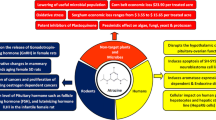Abstract
An analytical method using pentafluorobenzyl bromide (PFBB) derivatization and gas chromatography/mass spectrometry (GC/MS) has been applied to identify and quantify chloro-, bromo- and dichlorophenols in air, water and sediment samples. Phenols in air sample were collected with a PS-2 Sep-PAKTM cartridge, and eluted with 2-propanol. For water and sediment samples, liquid-liquid extraction with dichloromethane was carried out, and the solvent was exchanged to 2-propanol. The phenols in the solution reacted with PFBB to form the corresponding pentafluorobenzyl esters. After extracting the derivatives into hexane, the determination was carried out by GC/MS with selected-ion monitoring. The detection limits of phenols in air, water and sediment were 0.0033–0.0073 µg/m3, 0.0066–0.0147 µg/L and 0.33–0.73 µg/kg, respectively. More than 90% recoveries of the halogenated phenols were obtained from real environmental samples spiked by the halogenated phenols. The three isomers of mono-chlorophenols were detected in sediment samples in the range of 5.2–9.2 µg/kg in wet weight basis.
Similar content being viewed by others
References
Environmental Health Criteria 93 “Chlorophenols other than pentachlorophenol”, 1989, World Health Organization, Geneva, 49.
L. H. Keith (ed.), “Complication of Sampling Analysis Methods”, 1991, US Environment Protection Agency, Washington, D.C., 389
Directica 80/70/CEE, “Diario Oficial de las Comunidades Europeas 30–8–1990”, 1990, European Community, Brussels, 30–38.
“Endocrine Disruptor and Dioxins”, 1998, KAGAKU (separate volume), Kagakudozin, Kyoto, 112
H. Matsubara and S. Nakayama, Suishitsu-odakukenkyu, 1990, 13, 827.
T. J. Boyd, J. Chromatogr. A, 1994, 662, 281.
I. Harrison, R. U. Leader, J. J. W. Higgo, and J. C. Tjell, J. Chromatogr. A, 1994, 688, 181.
Y. Kurata, Annual Report of Saitama Institute of Public Health, 1994, 21, 77
Method 8040 “Test Methods for Evaluating Solid Waste”, 1987, US Environment Protection Agency, Washington, D.C., SW-846.
D. R. Knapp, “Handbook of Analytical Derivatization Reactions”, 1980, John Wiley and Sons, New York, Chichester, Brisbane, Toront, 47.
“Manual of Analytical Method”, 1998, Canada Center for Inland Waters, The National Laboratory for Environmental Testing, Burlington, Ontario, 2.
Author information
Authors and Affiliations
Rights and permissions
About this article
Cite this article
Hanada, Y., Imaizumi, I., Kido, K. et al. Application of a Pentafluorobenzyl Bromide Derivatization Method in Gas Chromatography/Mass Spectrometry of Trace Levels of Halogenated Phenols in Air, Water and Sediment Samples. ANAL. SCI. 18, 655–659 (2002). https://doi.org/10.2116/analsci.18.655
Received:
Accepted:
Published:
Issue Date:
DOI: https://doi.org/10.2116/analsci.18.655




